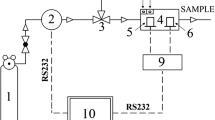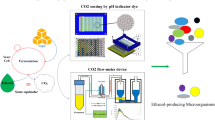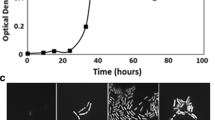Abstract
The close relation between metabolic activity and heat release means that calorimetry can be successfully applied for on-line monitoring of biological processes. Since the use of available calorimeters in biotechnology is difficult because of technical limitations, a new sensitive heat-flux calorimeter working as a laboratory fermenter was developed and tested for different aerobic and anaerobic fermentations with Saccharomyces cerevisiae and Zymommonas mobilis. The aim of the experiments was to demonstrate the abilities of the method for biotechnological purposes. Fermentations as well as the corresponding heat, substrate and product analyses were reproducible. During experiments the heat signal was used as a sensitive and fast indicator for the response of the organisms to changing conditions. One topic was the monitoring of diauxic growth phenomena during batch fermentations, which may affect process productivity. S. cerevisiae was used as the test organism and a protease-excreting Bacillus licheniformis strain as an industrial production system. Other experiments focused on heat measurements in continuous culture under substrate-limiting conditions in order to analyse bacterial nutrient requirements. Again, Z. mobilis was used as the test organism. Ammonium, phosphate, magnesium, biotin and panthothenate, as important substrate compounds, were varied. The results indicate that these nutrients are required in lower amounts for growth than formerly suggested. Thus, a combination of heat measurements and other methods may rapidly improve our knowledge of nutrient requirements even for a well-known microorganism like Z. mobilis. *** DIRECT SUPPORT *** AG903062 00004
Similar content being viewed by others
References
Alexander MA, Jeffries TW (1990) Respiratory efficiency and metabolite partitioning as regulatory phenomena in yeasts. Enzyme Microb Technol 12:2–19
Auberson LCM, Stockar U von (1992) A unified stoichiometric model for oxidative and oxidoreductive growth of yeasts. Biotechnol Bioeng 40:1243–1255
Bar R (1988) Fermentation calorimetry vs microcalorimetry. Trends Biotechnol 6:55–60
Battley EH (1987) Energetics of microbial growth. Wiley, New York
Beaubien A, Jolicoeur C (1984) The toxicity of various heavy metal salts, alcohols and surfactants to microorganisms in a biodegradation process: a flow microcalorimetry investigation. Drug Chem Toxicol 1:261–281
Beaubien A, Jolicoeur C (1985) Applications of flow microcalorimetry to process control in biological treatment of industrial wastewater. J Water Pollut Control Fed 57:95–100
Belaich JP, Senez JC (1965) Les développments récents de la microcalorimetrie et de la thermogenèse. Colloq Cent Natl Rech Sci 156:381–394
Birou B, Stockar U von (1989) Application of bench-scale calorimetry to chemostat cultures. Enzyme Microb Technol 11:12–16
Boe I, Lovrien R (1990) Cell counting and carbon utilization velocities via microbial calorimetry. Biotechnol Bioeng 35:1–7
Bringer-Meyer S, Scollar M, Sahm H (1985) Zymomonas mobilis mutants blocked in fructose utilization. Appl Microbiol Biotechnol 23:134–139
Bunker JC, James AM (1989) Microcalorimetric studies of the effects of platinum group metal complexes on bacterial growth. Microbios 58:83–93
Doelle HW, Kirk L, Crittenden R, Toh H (1993) Zymomonas mobilis — science and industrial application. Crit Rev Biotechnol 13:57–98
Fein JE, Charley RC, Hopkins KA, Lavers B, Lawford H (1985) Development of a simple defined medium for continuous ethanol production by Zymomonas mobilis. Biotechnol Lett 5:1–6
Galani I, Drainas C, Typas MA (1985) Growth requirements and the establishment of a chemically defined minimal medium in Zymomonas mobilis. Biotechnol Lett 7:673–678
Gandman M Vecht S, Zomer E (1983) The use of bioactivity monitor for process optimization and scale up of Bacillus thuringiensis fermentation. World Biotechnol Rep 1:665–670
Gustafsson L (1991) Microbiological calorimetry. Thermochim Acta 193:145–171
Hartung J (1986) On the use of flow microcalorimetry in estimating the biological effect of adverse substances on E. coli. Zentralbl Bakteriol Mikrobiol Hyg [Ser B] 183:36–46
Hemminger W, Höhne G (eds) (1984) Calorimetry — fundamentals and practice. VCH Weinheim
Hübner U (1990) Entwicklung neuer on-line-Analysemethoden zur Steuerung und Regelung von Proteasefermentationen. PhD thesis, Institut für Technische Chemie, Universität Hannover
Jöbses IML, Roels JA (1986) The inhibition of the maximum specific growth and fermentation rate of Zymomonas mobilis by ethanol. Biotechnol Bioeng 28:554–563
Jolicoeur C, To TC, Beaubien A (1988) Flow microcalorimetry in monitoring biological activity of aerobic and anaerobic wastewater-treatment processes. Anal Chim Acta 213:165–176
Käppeli O, Gschwend-Petrik M, Fiechter A (1985) Transient responses of Saccharomyces uvarum to a change of the growth-limiting nutrient in continuous culture. J Gen Microbiol 131:47–52
Kleeff BHA, Kuenen JG van, Heijnen JJ (1993) Continuous measurement of microbial heat production in laboratory fermenters. Biotechnol Bioeng 41:541–549
Lamprecht J, Hemminger W, Höhne GWH (1991) Calorimetry in the biological sciences. Thermochim Acta 193 (special issue)
Larsson C, Blomberg A, Gustafsson L (1991) Use of microcalorimetric monitoring in establishing continuous energy balances and in continuous determinations of substrate and product concentrations of batch-grown Saccharomyces cerevisiae. Biotechnol Bioeng 38:447–458
Luong JH, Volesky B (1983) Heat evolution during the microbial process — estimation, measurement, applications. Adv Biochem Eng Biotechnol 28:1–40
Marison IW, Stockar U von (1987) A calorimetric investigation of the aerobic cultivation of Kluyveromyces fragilis on various substrates. Enzyme Microb Technol 9:33–43
Meier-Schneiders M, Eigenberger G (1993) Biokalorimetrie —Methoden und Nutzungspotential. Biotec 4:6–9
Meier-Schneider M, Grosshans U, Busch C, Eigenberger G (1992) Investigation and control of fermentation processes using fermenter-calorimetry. In: Kreysa G, Driesel AJ (eds) Dechema-Biotechnology Conference, vol 5. VCH Weinheim pp 403–407
Ott J, Meier M, Eigenberger G (1991) Development of a laboratory fermenter-calorimeter for aerobic and anaerobic fermentations. In: Reuss M, Chmie H, Gilles ED, Knackmuss HK (eds) Biochemical engineering — Stuttgart. Fischer, Stuttgart, pp 352–356
Randolph TW, Marison IW, Martens DE, Stockar U von (1990) Calorimetric control of bed-batch ferementations. Biotechnol Bioeng 36:678–684
Regenass W (1983) Thermische Methoden zur Bestimmung der Makrokinetik. Chimia 37:430–437
Riesen R, Grob B (1985) Reaktionskalorimetrie in der chemischen Proze\entwicklung. Swiss Chem 7:39–43
Royce PN (1993) A discussion of recent developments in fermentation monitoring and control from a practical perspective. Crit Rev Biotechnol 13:117–149
Russel JB (1986) Heat production by ruminal bacteria in continuous culture and its relationship to maintenance energy. J Bacteriol 168:694–701
3and W (1987) Mikrokalormetrie — lein modernes Verfafren für biologische Fragestellungen. Forum Mikrobiol 220-223
Sonnleitner B, Fiechter A (1993) Impacts of automated bioprocess systems on modern biological research. Adv Biochem Eng Biotechnol 46:143–159
Stockar U von, Marison IW (1989) The use of calorimetry in biotechnology. Adv Biochem Eng 40:92–136
Stockar U von, Marison IW (1991) Large-scale calorimetry and biotechnology. Thermochim Acta 193:215–242
Stockar U von, Marison IW (1993) The definition of energetic growth efficiencies for aerobic and anaerobic microbial growth and their determination by calorimetry and by other means. Thermochim Acta 229:157–172
Tiefenbrunner F, Haller T, Wei\ C, Redl B (1987) Methods for detection of microbial activities in solid waste samples. Forum Staedte-Hyg 38:144–150
Traore SA, Belaich JP (1981) Microcalorimetric study of a well defined mixed culture. Entropie 98:55–59
Wadsö (1988) Progress and problems in microcalorimetric work on mammalian cell systems. Thermochim Acta 137:1–10
Author information
Authors and Affiliations
Rights and permissions
About this article
Cite this article
Meier-Schneiders, M., Grosshans, U., Busch, C. et al. Biocalorimetry-supported analysis of fermentation processes. Appl Microbiol Biotechnol 43, 431–439 (1995). https://doi.org/10.1007/BF00218445
Received:
Revised:
Accepted:
Issue Date:
DOI: https://doi.org/10.1007/BF00218445




